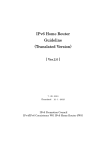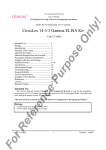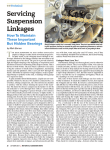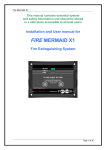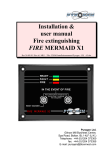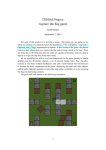Download Ocean Book
Transcript
SUPPORT OCEAN Thanks for checking out Ocean. This PDF is the free version of the game. Feel free to pass it around and share it. My name is Jake Richmond, and I designed, wrote and illustrated Ocean. If you like the game you can order a print copy of the book through the links below. The money buys me free time, which I use to make more games. Thanks, Jake Richmond BUY OCEAN AT: Atarashi Games The indie rpg un-store Amazon.com EVERYONE SHOULD SEE THE OCEAN BEFORE THEY DIE BY JAKE RICHMOND special thanks to Michael Petersen 1st edition, June 2009. Ocean is copyright 2009 Jake Richmond. Visit our website at Atarashigames.com Here’s the elevator pitch: We’re a group of people trapped in an underwater research station. We can’t remember who we are or why we’re there. We don’t know what the monsters are that are picking us off one at a time. All we know is that we need to get out. We want to escape. That’s what Ocean is about. Ocean is an engine for creating a very specific kind of story. What you’ll find in this book are a set of suggestions, ideas, illustrations and advice. If you follow these instructions, if you take my idea and run with them, you’ll end up with a neat story and role-playing experience. Something that’s part story, part performance and part game. Your results will be different from mine. Since we’re different people who take different approaches to telling stories, role-playing and creating fiction, we’re bound to not only approach Ocean differently but also get different results. That’s totally fine. As you read through this book you’ll see that Ocean isn’t really a complete game, rules set or guide. There are holes that need to be filled. The approach I take to playing Ocean, to using Ocean to create a story, relies on my previous experience as a gamer, storyteller and artist. I can’t recreate that for you. You’ll have to approach Ocean on your own and fill in the gaps using your own experiences. That shouldn’t be too hard. This book is broken into three parts. The Operations Manual has all the instructions. If Ocean is a game, then these are the rules. The User Manual has all my advice, and ideas for creating a shared fiction using those rules. The Afterword talks about what went in to creating Ocean. There are also some comics. Those were a lot of fun to draw. Jake Richmond March 2009 [email protected] OPERATIONS MANUAL The Operations Manual contains the instructions for staging Ocean. I’ve tried to present these instructions as cleanly and concisely as possible. You’ll find commentary, advice and suggestions for using these instructions in the User Manual. Premise: You wake up cold, in the dark. You are not alone. You can’t remember who you are and you don’t recognize the room you’re in or the people around you. You’re in the ocean, deep underwater in some kind of abandoned research station. Who are you? What is this place and why are you here? What are the strange, monstrous noises coming from the abandoned parts of the Station? What are the creatures that shuffle and splash through the flooded halls and corridors? How will you escape to safety? Can you escape at all? How do we play Ocean? Ocean is a story that we’ll tell together. It has a beginning, as well as rules and guidelines that will help us reach its end. We’ll take on the roles of desperate amnesiac survivors and work together to tell the story of how we solved the mysteries surrounding our situation and escaped from a deserted underwater research station. Creating a story together is easy. The rules and guidelines in this book give us a frame to build on. We’ll start with our characters and their desperate circumstances and build from there. We’ll take turns suggesting scenes to play out, describing the places we explore and clues we uncover, and narrating the truths behind Ocean’s mysteries. We’ll each act out the part of a character, speaking in their voice and describing their actions and emotions. We’ll role-play with each other, creating and exploring our characters’ relationships as we go. You’ll need two or more participants for Ocean, as well as some paper, a few pencils and nine dice (six-sided) for each player. Goals: Ocean has a beginning and an end. To reach this end our characters will need to complete two goals: solve the mysteries and escape alive. These goals are the core of the story that we’ll create. They’re what drive our characters forward and force them to take risks. We’ve finished our story and won the game once these two goals are met. Solve the Mysteries: Ocean has three central mysteries: Who are the survivors? What is the Station? What are the monsters? These mysteries are purposely vague and spawn lots of other questions. It will be up to us to define the truth of each mystery. We’ll get to that in a bit. Escape the Station: At least one of the survivors needs to escape to safety alive. We’ll get to exactly what counts as safety in a bit as well. The three mysteries in detail: Since the mysteries are central to the game, let’s take a close look at each of them. Who are the survivors? You can’t remember who you are. You’ve woken up in a strange place surrounded by strange people, with no memory of how you got there or what your life was like before. You still have a sense of self, a feeling that you had a life and personality of your own. You have flashes of memory, vague recollections of people and places that were important to you. What is the Station? You wake up to find yourself in a cold, dark room, connected to other rooms by a series of sealable hatches and corridors. You appear to be in some kind of underwater station. Strange machines sit in the shadows, some humming with electricity, others dead. Their purpose is unknown. Lights flicker in partially flooded corridors. Was this a research station? A medical facility? A prison? Why were you brought here? Or did you live here all along? What is the purpose of the Station? What are the monsters? Almost as soon as you wake up you begin to hear strange noises coming from deeper in the Station. As you begin to explore you’ll catch glimpses of movement out of the corner of your eye. Strange creatures lurk in the shadows and flooded halls of the Station. What are they? Where do they come from? Do they want to hurt us or help us? Were they created in the Station, or did they come from the Ocean? Get Started: We’ll start by creating our characters. Remember, we don’t know who these survivors are, where they are from or how they came to the Station. It’s all a mystery! All we know for sure is what the premise told us: We don’t know who we are, where we are, or why we were brought here. All we know is that we want to escape! Creating a survivor is pretty easy. Just follow the steps listed below. I like to hand out index cards to each player so they can keep notes and write down the information about their survivor. 1. Start with age and gender. Roll two dice. The result of the first determines your survivor’s gender. High is female, low is male. The second die determines your age. The number on the die is the first digit of your age. A two means your survivor is in their 20’s. A six means they’re in their 60’s. Remember, your survivor won’t remember exactly how old they are! 2. Each survivor wears hospital pajamas and has an ID card around their neck with a name on it. Don’t choose a name yet! We’ll get to that. 3. Each player gets 9 dice. Set these in front of you in a pile. 4. Each survivor gets 1 skill. Choose a random skill from the skill list (which you can find a few pages over). This skill is a link to your survivor’s previous life, a representation of something they were good at, or maybe a job they held. You can keep this skill a secret or let everyone know about it. 5. Before we go any further we’re actually going to play a little scene. We’re going to describe what happens as each of us wakes up. It doesn’t matter which one of us starts. You’ll describe to us what you see and feel as you wake up and look around. You’ll tell us how you react and what you do. After you’re done, the player to your right gets to wake up. We’ll continue this till all our characters are awake. As the characters are waking up and looking around they’ll be seeing each other for the first time, giving each other confused looks or speaking in hushed, hesitant voices. The purpose of this scene is to give us a first impression of who the survivors are. We should each try to do 3 things in this scene: a. We’ll take turns saying a little bit about our characters, saying what they look and sound like and describing how they react to waking up without memories in this strange place. b. We’ll describe at least one detail of our surroundings. This will help us establish where we are right away. c. We’ll get to describe one detail about the survivor belonging to the player sitting to our right. Since that survivor is wearing a name tag, we also get to give them a name! 6. Our survivors may not know who they are, but they feel certain connections with each other. The survivor to your right is someone you feel you need to protect. The survivor to their right is someone you instinctively don’t trust. 7. Each character is especially interested in solving one of the three secrets. Choose one of the secrets (or roll a dice to determine one at random). This will be the secret you’ll try to solve first. Think about why it may be important to you. We’ll talk about this more later. Don’t tell anyone! No one will understand why this secret compels you! Play: Our story starts when we wake up in a cold, dark room. It ends when we solve our mysteries and escape to safety. Getting from the start to the finish is the fun part. We’ll use the three steps below to tell our story and reach our goals. 1. We’ll explore the Station by taking turns describing locations and scenes. 2. We’ll explore until we encounter an obstacle. 3. We’ll risk dice to overcome obstacles. Describing locations and scenes: We move through our story by exploring the station, taking turns describing the new rooms we discover. Description, narration and roleplaying are our tools here. Our understanding of our situation, our surroundings and our options rely on good, detailed description. We should take our time and paint as vivid a picture as we can. Descriptions will lead to scenes of our characters exploring and interacting with each other. We should ask each other questions, share information and try to help each other out. We can speak in our characters’ voices or simply describe their actions. We’ll keep exploring and describing what we find until we run into an obstacle. Encountering Obstacles: An obstacle is anything that keeps us from reaching our goals. Obstacles block our progress and force us to either turn back, find a different way to proceed, or risk dice to overcome them. An obstacle can come in any form, and can include physical obstructions like a flooded passageway or sealed door, personal obstacles like fear, exhaustion, or injury, or obstacles presented by another person, creature or animal. Obstacles can be introduced by any player at any time, although it’s best if we deal with just one obstacle at a time. We’ll introduce obstacles as we explore the station as part of our descriptions. Obstacles are always about choice. When confronted with an obstacle, we need to be able to choose whether we want to risk dice to overcome it, or turn back and look for another path. We should never use obstacles to force each other into taking specific actions. Instead, we’ll present obstacles that challenge each other to make difficult and interesting choices. Risking dice: We can overcome obstacles by risking dice. Risking dice is dangerous, but it’s also the only way to reach our goals. Take a risk by telling us what you’ll do to overcome the obstacle. Before you roll your risk dice, the player you don’t trust will decide what’s at stake if you fail. Once you know what you’re risking, you can go ahead and roll your dice. You can roll up to 3 dice to win a risk. You’ll need to roll at least one five or six to win the risk. We’ll talk about how we narrate the outcome of the risk in just a minute. If you win a risk, all dice that came up five or six are given to the survivor you need to protect. These are called bonus Dice. You’ll keep any dice that came up 1, 2, 3 or 4. If you lose a risk, if none of your dice come up five or six, you’ll give one of your dice to the survivor you don’t trust. This is also a bonus die. You’ll discard the rest of the dice you risked. Describing success and failure: Risks are never safe. Because you’re risking yourself to reach your goal, even a success will come at the cost of scrapes, bruises, exhaustion or worse. Failure guarantees that you’ll be mangled, mutilated or otherwise injured. Don’t take a risk unless you’re ready to get hurt! If you win the risk, you get to describe what happens. Tell us how you overcame the obstacle, and what happens because of your actions. Because winning a risk involves losing some dice, tell us how you hurt yourself while overcoming the obstacle. If you lost the risk, you don’t get to describe the result alone. The character you don’t trust got to decide what was at stake if you failed and you’ll both work together to describe the harm that comes to you as a result of the risk. Whether you win or lose a risk, you should use your description to further our story and push us closer to our goals. Hurt and Dying: Our dice represent how safe and healthy our characters are. When we risk dice what we’re risking is ourselves. We’re putting ourselves on the line to take horrible wounds, to suffer from sickness and exhaustion, to even die, so we can get past an obstacle and get closer to our goals. Once we lose dice we’ll never get them back! When we lose dice in a risk we’ll use this chart to determine how hurt we are. 9 Dice = unhurt 6 Dice = hurt, exhausted or terrified 3 Dice = very badly hurt, near the limits of endurance 0 Dice = dead When one of us dies our bonus dice and items are divided between the surviving characters. It’s up to us to work out how the dice and items are divided. You can still participate in the game after your survivor dies. You’ll still need to help describe scenes and create obstacles. You’ll still need to decide what’s at stake when the survivor that doesn’t trust you takes a risk. If you gain bonus dice from another survivor’s risk, you can either pass them all on to the survivor to your right, or buy an item and narrate how one of the survivors finds it. Taking risks against other survivors: Sometimes you may want to take a risk to try to hurt or kill another survivor. If you win a risk with the intent to hurt another survivor, you can reduce their dice down to the next level. So you could knock a survivor from unhurt to hurt, or from hurt to very badly hurt. If your intent is to kill another survivor then they will be reduced to 0 dice if your risk succeeds. Solving the mysteries: Our story has three central mysteries. Who are we? What is the station? What are the monsters? We’ll need to solve all three of these mysteries to win the game. Each of these mysteries is purposely vague, and you won’t find any definitive answers or truths in this book. It will be up to us to create the truth behind these mysteries. As we tell our story we’ll gather clues, and each clue will give us a chance to narrate a larger part of one of the mysteries. We solve mysteries buy buying clues: Clues are bought with bonus dice. You can buy a clue at any time as long as you have enough bonus dice. What this means is that your character has discovered something, or remembered something, that sheds light on one of the mysteries. Buying a clue lets you describe part of the truth behind one of those mysteries. You get to decide what’s really going on. Are the strange creatures that hide in the submerged sections of the Station really aliens? Is the Station really a time capsule meant to preserve the last surviving humans? Are you and the other survivors actually imprisoned spies who have had their memories erased? While buying a single clue doesn’t allow you to determine the entire truth behind a mystery, it does let you lay the groundwork for that mystery and establish a single truth that must be recognized by the other players. It takes three clues to solve a mystery. The player who buys the mystery’s third clue gets to wrap up the mystery and establish its final truth. Clues always reveal something about one of the survivors. Our survivors are connected to the mysteries, and each clue will shed light on that relationship. When you buy a clue you’ll decide if it sheds light on the survivor you need to protect or the survivor you don’t trust. You get to describe what the clue is and what it reveals about that survivor. Use your clue to connect the survivor to the mystery and introduce new ideas into the story! Remember, each of us is interested in solving a specific mystery. When you buy a clue, you have to spend it on that mystery. Once that mystery has been solved, you can spend your clues to solve other mysteries. If you don’t have enough bonus dice to buy a clue, you can ask other players to donate bonus dice. You can get up to two extra bonus dice in this way. The players that donate the dice get to contribute to the description of the clue. As we play and create our story we’ll come across all kinds of discoveries that will let us speculate on the truth behind the three mysteries. It’s important to remember that only the clues that we buy with bonus dice are established truths. Everything else is speculation, and may or may not be true. By buying clues and narrating their importance you are telling the rest of us what story elements you are interested in and how you want our game to proceed. Remember that! Escaping the station: In order to win the game at least one of the survivors must survive and escape to safety. What exactly qualifies as safety will depend on the story we’ve told, although it will almost always involve escaping the station. In some stories, safety will be finding an abandoned submarine and sailing toward land. In others, it may involve being rescued by the navy, finding our way home, or making contact with aliens. If the survivors reach a point where they are no longer in real danger, where they can rest, treat their wounds, or communicate with other people that don’t want to kill them, then they’ve probably found safety. Remember, only one of us has to survive to win the game! While you don’t have to wait till after you’ve solved the mysteries to find safety, you won’t be able to earn any more bonus dice after you’ve escaped. So remember, it’s a bad idea to escape until you’ve already solved all the mysteries or have enough bonus dice to buy the clues you need to solve them. Bonus Dice: You gain bonus dice when other survivors take risks. You may also get some bonus dice if another survivor dies. These are the only ways to get bonus dice! We keep our bonus dice separate from the nine dice that we get at the start of the game. They’re different kinds of dice that do different things. Bonus dice never count toward the number of dice you have for determining how hurt you are. There are three things you‘ll use bonus dice for: 1. Buy clues. Each clue costs three bonus dice. 2. You can always add a single bonus die to a risk roll. If this die comes up a five or six then it counts as a success and you’ll give it to the character you want to protect. If not, just discard it. 3. Buy items. Each item costs one die. Discard your die and draw a random item from the item list. Your discovery of the item should be narrated into a scene as soon as possible. Items: The station is full of discarded items for us to find. While we may pick up all kinds of stuff as we explore, items that have mechanical benefits like those described below can only be bought with bonus dice. Items are always selected randomly, and usually don’t last long. After you use an item, roll a die. On a five or six you’ll keep the item, otherwise it’s used up. Aspirin: Gain one bonus die after your next risk. Flashlight: Roll an extra die in risks involving being in complete darkness. Pistol: Roll two extra dice in risks against monsters or other characters. Gain 1 bonus die by giving this item to the survivor you need to protect Keys: Roll an extra die in risks involving locks. Knife: Roll one extra die against monsters or survivors. You only need to roll a three or better keep this item. Energy Drink: Re-roll your next Risk. Old Journal: Gain a Clue. Shotgun: Get one automatic success in risks against monsters or survivors. Gain two bonus die by giving this item to the character you need to protect. Cigarettes: Roll one extra die in any risk except against monsters or survivors. Manual: Gain a new skill. Bullet Proof Vest: When you lose a risk keep one bonus die instead of giving it to the survivor you don’t trust. If a survivor tries to kill or hurt you, you’ll only lose one die. Skills: Each survivor starts with a skill. Skills are half-remembered, left over bits of our lives that we can use to explore the station and survive. We’ll draw a random skill at the beginning of the game. Skills let us roll extra dice in certain risks. Argue: Roll an extra die in risks against survivors. Climb: Roll an extra die in risks that involve climbing. Computers: Roll an extra die in risks that involve computers. Sabotage: Roll an extra die in risks to break or ruin machines, weapons, locks or other objects. Fight: Roll an extra die in risks that involve fighting. First Aid: Roll an extra die in risks that involve administering medical aid. Hide: Roll an extra die in risks that involve hiding. Hold Breath: Roll an extra die in risks that involve being underwater. Jump: Roll an extra die in risks that involve jumping. Mechanic: Roll an extra die in risks that involve machines. Pilot: Roll an extra die in risks that involve vehicles. Run: Roll an extra die in risks that involve getting away. Strength: Roll an extra die in risks that involve moving or lifting things. Continuing the story: Our story doesn’t have to end after we solve our mysteries and escape to safety. Maybe the safety we’ve found is only temporary? Maybe we’ll escape the Station to find ourselves surrounded by new mysteries and dangers! If we decide we want to continue our game we’ll need to establish two or three new mysteries, as well as a new setting. By this point we’ve solved the original three mysteries, but there’s still a good chance that we have a lot of unanswered questions! As we start our new story the survivors from our last story can each select a new skill for free! Since they’ve had time to heal and rest they can also spend any left over bonus dice to buy back normal dice! This is the only time they can do this! Players without characters can create new survivors. They probably won’t be amnesiac escapees from an underwater station, but otherwise the process for creating new survivors is the same as before. USER MANUAL The User Manual contains advice, suggestions and ideas for staging Ocean. You can take this advice or ignore it. There’s no right or wrong way to approach Ocean. My hope is that this section will provide some insight into my own approach to using the Ocean engine. This is the stuff that I think will lead to a really solid and fun story telling and role-playing experience. I’ve arranged these thoughts as loose paragraphs, in no particular order. What you’ll read here is pretty much what you’d get from me if we sat down and had a conversation about how to use Ocean. I suggest reading through it all and marking the parts that you think will be useful. Ignore anything that sounds like it might not be fun! Attitude and taking an open approach to play: Ocean is the kind of thing that only works if you actually want it to. If the premise of Ocean doesn’t appeal to you, if you aren’t interested in the story of amnesiac survivors trying to solve the mystery of what happened to them and escape with their lives, then you really shouldn’t participate. If that sounds a little harsh, consider that if we’re going to tell the best story we can and create the best experience possible we need to be totally enthusiastic about what we’re doing. If we want Ocean to work, if we want to explore our characters and these mysteries, if we want to tell this story, then we need to be willing to approach these ideas with a willingness to invest ourselves. If we can’t do that, our story will likely run into some trouble. Thankfully, investing ourselves isn’t as hard as it sounds. The important thing to remember is that we’ll get out of this experience what we put into it. Tone: It’s important to talk about the tone of the story before you get started. I think of Ocean as a survival/mystery story, and the approach I take focuses on creepy environments and slow building tension. You may want to play Ocean as straight out horror, full of gore and nastiness. Someone else might want an explosive action story, or a subdued drama. Other participants might want to add in some comedy or romance elements. Talk about what you want to get out of the story and make sure everybody is on the same page before you start playing. If you find that what you want conflicts with what someone else wants, you’ll need to reach a compromise. That’s important. Don’t agree to disagree, and then try to force the story in the direction you want it to go. Instead, consider why the other person wants to take a different approach then you. Ask yourself if taking their approach will still allow you to enjoy the story. If the answer is yes, then that’s the path you need to take. Compromise is fun! I really, really think that talking about tone and setting expectations for what kind of story you want to tell is the best way to ensure a good storytelling experience. Don’t skip this part! Getting from the beginning to the end: The rules in the Operations Manual provide a map for getting from the first scene of the story where our characters wake up to the end where they make their escape. Because we all have different ways we tell stories and play games, we’ll naturally have different approaches to using these rules and following this map. Here’s how I do it. Break the events of your game into different scenes. Set a scene by describing where the characters are and what they see. You can do this by yourself or with the help of other players. Once the location of your scene is set in everyone’s mind, explore the scene and see what’s there. Open doors. Walk down halls. Touch and see as much of the scene as you can, and take turns describing for each other what you see and find. Description is important! Ocean is all about describing things. The more you describe, the more real and interesting your story will be. Present an obstacle. Once the scene is established, present an obstacle that keeps the characters from their goals. A door that won’t open. A password protected computer. A monster blocking the only door to the submarine bay. Make sure the obstacle blocks something that the characters actually want. Offer them a choice. They can take a risk and get closer to their goals, or they can look for another way to move forward. Remember, any of us can present obstacles, but it’s important that we take turns. If someone else is already describing an obstacle give them their space without interrupting. If you’ve just described an obstacle, let someone else have a turn. It’s okay to ask everyone if you can take a turn. In fact, it’s better to ask then to just jump in! Scene -> Descriptions -> Obstacles -> Risks Always move toward your goals. Your character wants to solve the mysteries and escape the station. Remember that! If you’re not sure what to do, look for ways to move closer to your goals. It’s okay to use your own narration and descriptions to push yourself closer to your goals. The flip side of that is you need to be providing the other players with ways to do the same thing. Create scenes and obstacles, or add details to scenes and obstacles created by other players, that provide the characters opportunities to reach their goals. Again, if you’re not sure what to do, provide another player with descriptions and obstacles that push them toward their goals! Engaging characters: We want to solve the mysteries. We want to escape. These are our characters’ goals. When we describe scenes and create obstacles we should keep these goals in mind. Does the obstacle keep the characters from reaching their goals? Does the scene lead the characters closer to their goals? Description is our tool for creating story and engaging characters. Our opportunities for description are pretty broad. Creating scenes is all about description. This is where we can add the most detail into our story. Use your scene descriptions to introduce interesting elements that we can explore to reach our goals. Obstacles are all about pushing characters toward their goals. If an obstacle is overcome the characters will be closer to their goals. Use your descriptions of obstacles to encourage the characters to take risks. Use your descriptions of risks to create new plot and push the characters closer to their goal. Don’t just describe the success or failure of the risk, tell us what interesting things happen because of it. Use the description of the risk to set up the next scene or obstacle. You can grab a character’s interest by creating story around the things that matter to them. Each character is especially interested in one of the three mysteries. Each character has a character that they want to protect, and another they don’t trust. Each character is worried about their own survival. They want to escape the station. They want to live! These are your components for creating interesting scenes and obstacles that the other characters will want to engage in. Obstacles and risks: Risks are about choice. You should never force a character into taking a risk. Don’t describe how a giant, tentacled monster bursts from the floor and then declare that the characters must fight or die. Confronting an obstacle should be an option. The characters need to be able to choose to not take the risk, and instead find a different way to reach their goals. Characters will find obstacles where you least expect them. When a character says they want to do something, when they want to open a door, swim down a passage, kill a monster or translate a language, what they’re doing is asking your permission. We get to decide if what they want to overcome is actually an obstacle. If they want to swim down a flooded hall, does that count as an obstacle? If we think it’s hard, if we think it’s something that the character would struggle to do, then yes, it’s totally an obstacle. The character needs to risk dice to do it. If a character wants to do something that will let them reach one of the goals, that’s a damn good time to throw an obstacle in! The characters need to decide how to overcome an obstacle. If they decide to take a risk, it’s up to them to decide what that risk looks like. The character can certainly try to fight the monster. Or they can take a risk to try to escape from it, hide, outsmart it, trick it, or just sneak by it. Risks aren’t always personal. Sometimes a risk affects more then just the character that takes it. You can take a risk to sneak the entire group past a sleeping creature, or help another character climb up a ruined elevator shaft. Stakes should be harsh. You’ll always decide what’s at stake when the character that doesn’t trust you takes a risk. Mechanically, all they can lose is the dice that they risk. But that’s only part of it. It’s your job to make sure that the risk is actually a risk. You’ll decide what’s at stake, what they could lose if they fail the risk. A good stake will make the character reconsider their risk. A good stake puts more than the character’s own health and safety in danger. The dice economy: You need bonus dice to win the game. Bonus dice buy clues and clues let you solve mysteries, so the only way to beat the game is to get a whole bunch of bonus dice. The only way to reliably generate bonus dice is to take risks. The dice economy will start slow. At first no one will have any bonus dice, and it will take a few risks to get things doing. The more risks we take, the more bonus dice we’ll have available. That doesn’t mean we should take suicidal risks just to generate more dice. But we shouldn’t be afraid of risks either. Our characters will have to take some chances if they want to make it out alive. Taking risks doesn’t actually get you any dice. You’ll rely on the people to your left for that. Since the characters that want to protect you and don’t trust you will give you dice when they take risks, you should do your best to describe conflicts and plot that will encourage them to take those risks. That’s your job! The more you push them toward their goals, the more bonus dice they’ll give you. Pace: You may have noticed that the game can end as soon as you collect nine bonus dice. That’s all you need. What this means is that once you reach a certain point you can pretty much end the game at any time. This doesn’t mean you should rush to an ending. Instead, pace yourselves and let your story build to a satisfying conclusion. If you get to the point where there are plenty of bonus dice to go around but you’re not ready to end your story, don’t be afraid to buy some items or spend some dice to supplement your rolls. If you decide you want a shorter or longer game you can always adjust the number of bonus dice needed to buy clues. I wouldn’t suggest reducing or raising the cost by more than one die either way. Getting hurt and dying: Overcoming an obstacle always involves doing something dangerous. When you take a risk, you’re saying that you’re willing to trade your safety for a chance to get closer to one of your goals. Whether your character wins or loses their risk, they still lose dice. They still get hurt. The difference is that if they win they get hurt AND get what they want. The risk was worth it! Our health and safety is measured by our dice. We start the game with nine, and the more we lose the worse off we are. Here’s the chart again: 9 Dice = unhurt 6 Dice = hurt or exhausted 3 Dice = very badly hurt, near the limits of endurance 0 Dice = dead As long as you have seven or more dice, you’re pretty much fine. You may be tired, bruised and bloody, but you wouldn’t call in sick to work. Once you get down to six dice you’ve been hurt or exhausted. You won’t die, but you need medical attention. You should probably be in a hospital. At three dice, you’ve been hurt very badly. If you don’t get medical attention fairly soon you’ll probably die. Maybe you took a big dose of radiation. Maybe you lost an arm. Maybe you have been floating in the ocean for days and are dying from exposure. When you lose your last die you’re dead. That’s that. When we describe the consequences of our actions we need to take into account how many dice we lost and where that puts us on the chart. If I risk a single die and am reduced to eight, we can describe the injury from my risk as a minor scrape, twisted ankle, or some bruises. If I lost 3 dice, we need to describe the injury in terms of broken bones and major bleeding. Very likely one or more of us will die. Maybe all of us. That’s fine. It’s probably a better story if a few of the characters don’t make it out alive. Remember, death doesn’t end our participation in the game. Instead, it lets us focus on describing scenes and obstacles. If it looks like your character might die then go ahead and give them an awesome death. Go out in a blaze of glory. Make a noble sacrifice. Betray your friends and pay the price. Make your death an interesting and vital part of our story. That’s what we’re here for. To tell a good story. Authority: Ocean doesn’t have a game master. No single player is in charge of creating our story or deciding whose contributions are valid and whose can be ignored. We work together to tell our story. Each player has the same amount of authority and the same responsibilities. This means that sometimes we’ll disagree. Sometimes I’ll introduce an idea into play that you don’t like. Sometimes you’ll insist that my character shouldn’t be able to do something that I really think they should do. We need to remember that we’re trying to create a story together. It’s better to compromise then argue. It’s better to accept and work with each other’s ideas then to reject them. The other side of this is that not everyone will use the same amount of authority. Some players will emerge as the game’s leaders, stepping forward to describe most of these scenes and obstacles and reveal the truth behind most of the mysteries. Other players won’t want much authority at all. They’ll play the part of their characters and be happy to follow the leads the other players give them. Each approach is fine, and I think most of us will fall somewhere in between this. Maps and index cards: I like to draw maps as I play. I put an index card in the middle of the table, and fill in rooms, hallways and other features as we tell our story. I think this helps give the Station a real presence, and it definitely makes it easier to navigate. I try not to be a map hog either. Everyone should be able to add notes, sketches, and new rooms to the map. I also like to hand out index cards to the other players at the beginning of the game. I always suggest that we fold them down the middle and set them in front of us, with our character’s name facing out toward the rest of the group. Like a school name sign? We can write down our character information on the back. Unpacking the 3 mysteries: Let’s talk about the possibilities surrounding each of the mysteries. The scenario described in this book is one that I find personally fascinating, and I had some very specific ideas in mind when I chose the three mysteries. In the end it will be up to you to determine the truth behind these mysteries, but maybe I can give you a few ideas. Who are the survivors? The name “survivors” implies that the characters have survived something. But what? Were they brought to the Station or have they lived there all their lives? Are they scientists, doctors, and researchers who have fallen victim to some kind of amnesia inducing accident? Are they the subjects (willing or otherwise) of some kind of memory manipulation experiment? Are the survivors really people at all? They could be androids or some other kind of artificial life form, clones, aliens or malignant AIs in a virtual reality program. If they are people, where did they come from? Where they kidnapped and brought to the Station against their will? Did they come to the Station seeking safety and refuge? What is the Station? I’ve pictured the Station as looking like the inside of the drilling rig in The Abyss, or like the interior of a naval ship. It’s clearly a manufactured place, and it’s definitely underwater. But what is it for? Has it been long abandoned, or was it fully functional until just recently? Was it some kind of underwater research station, and if so, who were the researchers and what was their subject? Maybe the Station wasn’t a research center at all, but a fallout shelter of some kind, or a prison. Maybe it’s a place set up specifically for making contact with the monstrous creatures that live in the ocean? Maybe it was built to be the first contact platform for an aquatic alien race? Is the Station really in the ocean? Is it really underwater at all, or are the flooding corridors and water filled portholes a trick to keep the survivors from trying to escape? What are the monsters? There’s something really scary lurking in the corridors and airlocks of the Station. Something not human. My initial idea for the monsters of Ocean were strange, shadowy, tentacled creatures that were at least somewhat human in appearance. Of course, they could look like and be anything you want. Are they mutated humans, or maybe the victims of cruel experiments? Are they the product of alternate evolution, hidden deep in the ocean? Are they members of a lost underwater civilization? I like this idea quite a bit. The real question isn’t what the monsters are, but what do they want? Are they mindless creatures out for blood and flesh? Do they want to suck your human brains out with their tentacles? Maybe they’re intelligent, but previous contact with humans has made them wary and hostile. Maybe they’re aliens searching out the last humans on the entire planet, the survivors locked in suspended animation deep in the ocean! Of course, the monsters don’t have to be monsters at all. Hostile soldiers with guns, creepy ghosts, strange hallucinations, evil scientists and even zombies are all viable options. Go nuts! Using clues to solve mysteries: Each clue is a chance to reveal a chunk of one of the mysteries. We need 3 clues to solve a mystery. That means each mystery is made up of three parts. You get to describe part of the truth behind the mystery when you buy a clue, but there’s good chance you won’t be the one to buy all three clues for a specific mystery. The smart approach is to take into account the ideas other players have already introduced into the game and use those to create your clue. It’s counterproductive to use your clue to try to contradict a clue that someone else has already introduced. Remember, we’re creating a story together! It’s okay to ask for help: This is my last bit of advice. If you’re not sure what to do or where to go, it’s okay to ask the other players for help. If you want to buy a clue but don’t know what to describe, ask for help. If you’re not sure what stakes to set for a risk, or if you’re not sure how to describe a success, go ahead and see what everyone else thinks. It’s okay to ask for a time out and have a little group-think table discussion. We tell better stories by working together. AFTERWORD Where did Ocean come from? There’s something about the ocean that has always frightened and fascinated me. When I was a little kid we used to visit my grandparents on the coast, and I had nightmares about strange men crawling out of the tide, dragging people from their bedroom windows and taking them off to… it was never clear where they were taken to. Ocean was pretty heavily inspired by Yuji Iwahara’s excellent manga King of Thorn, James Cameron’s film The Abyss and several different Playstation games in the survival/ horror genre. Creating Ocean: Ocean was my attempt to fully create a new game/story engine in a single month. The idea was that I’d design, write and illustrate the entire thing in 30 days. It didn’t work. It took almost twice that long. I had the idea for Ocean for a few months before I actually sat down to work on it. I worked out the text and typed it up the night before Go Play SE Portland #19, and played it for the first time at the event the next day. I spent the rest of that month reworking the text, testing the game and working on the comic. Why comics? It’s better to show then tell, right?















































